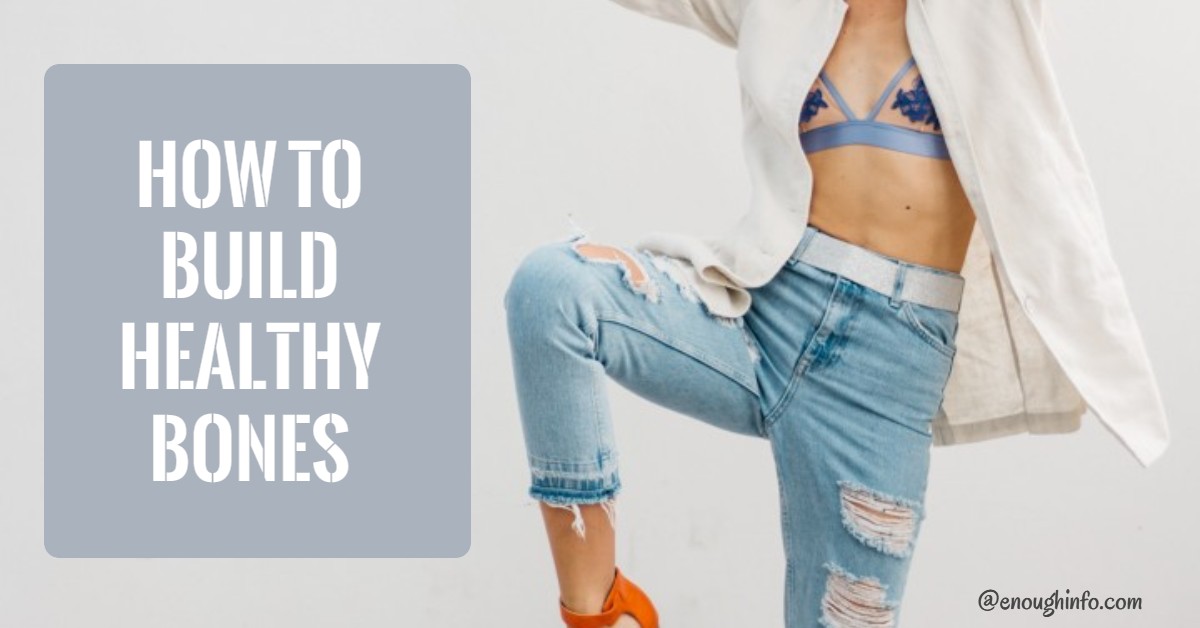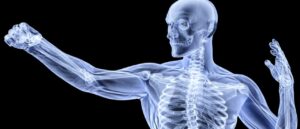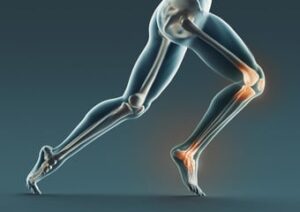How to Build Healthy Bones (Top Strategies: 2023)

It’s crucial to develop strong bones. That is the reason why you must know how to build healthy bones. The more reason why we wrote this article for you.

During childhood, adolescence, and the early stages of adulthood, minerals are integrated into your bones. You have reached your peak bone mass when you are 30 years old. Your chance of developing brittle, easily broken bones increases if insufficient bone mass is developed during this period or if a bone loss occurs later in life. Enough Info

Bones provide a variety of functions in the body, including giving structure, safeguarding organs, stabilizing muscles, and storing calcium. While it’s crucial to develop strong and healthy bones during childhood and adolescence, you may also take precautions to maintain bone health as you become older. Fortunately, there are several dietary and lifestyle choices that can help you develop strong bones and keep them as you age.
Why bone health is important
New bone is always being formed and old bone is constantly being broken down in your bones. Your bone mass increases when you’re young because your body produces new bone more quickly than it degrades existing bone. Around age 30, the majority of people reach their peak bone mass. Following that, you continue to lose slightly more bone mass than you gain as a result of bone remodeling.
How much bone mass you have by the time you are 30 and how quickly you lose it afterward determine how likely you are to develop osteoporosis, a disorder that makes bones weak and brittle. The more bone you have “in the bank” and the higher your peak bone mass, the less probable it is that you will get osteoporosis as you get older.
Read Also: How To Stop Drinking Alcohol ( Step- by Step- Guide )
What affects bone health?
Bone health can be affected by a variety of causes. For instance:
1. The calcium content of your diet.
A diet lacking calcium increases the risk of fractures, early bone loss, and lower bone density.
2. Physical exercise.
Physically sedentary people are more likely to develop osteoporosis than physically active people.
3. Tobacco and alcohol use.
According to research, smoking can cause brittle bones. The risk of osteoporosis may also be increased by routinely consuming more than one alcoholic drink per day for women or two alcoholic drinks per day for males. https://enoughinfo.com/how-to-build-healthy-bones/
4. Sex.
Because women have less bone tissue than males do, they are more susceptible to osteoporosis.
5. Size.
You run the danger of having less bone mass to draw from as you age if you are exceedingly thin (body mass index of 19 or less) or have a small frame.
6. Age.
As you age, your bones weaken and grow thinner.
7. Race and family history.
If you are white or have Asian ancestry, your risk of osteoporosis is the highest. Additionally, if you already have a family history of fractures, having a parent or sibling with osteoporosis increases your risk.
8. Hormone levels.
Bone loss can result from an excess of thyroid hormone. As estrogen levels fall in women throughout menopause, bone loss occurs significantly. Osteoporosis risk is also increased by amenorrhea, the prolonged absence of menstruation before menopause. Low testosterone levels in men might result in a loss of bone mass. https://enoughinfo.com/how-to-build-healthy-bones/
9. Eating disorders and other conditions
Bone deteriorates in both men and women who severely restrict their food intake and who are underweight. Additionally, procedures for losing weight and illnesses like celiac disease can impair your body’s capacity to absorb calcium.
10. Certain medications.
Corticosteroid drugs including prednisone, cortisone, prednisolone, and dexamethasone damage bone when taken over an extended period of time. Proton pump inhibitors, methotrexate, various anti-seizure treatments, such as phenytoin (Dilantin), selective serotonin reuptake inhibitors, and aromatase inhibitors used to treat breast cancer, may also raise the risk of osteoporosis.
Read Also: How To Make a Gravity Bong ( Step by step)

How to Build Healthy Bones
The following 10 natural methods will help you build stronger bones.
1. Eat a lot of vegetables
Want to know the starting point on how to build healthy bones? Start with your diet. You’ve got to eat right!
For strong bones, consume more vegetables. They are among the best providers of vitamin C, which promotes the growth of cells that make bones. Additionally, some research indicates that the antioxidant properties of vitamin C may shield bone cells from harm (2Trusted Source).
Additionally, vegetables appear to improve bone density, also referred to as bone mineral density. The quantity of calcium and other minerals in your bones is measured by their “bone density.” Low bone density is a feature of both osteopenia (low bone mass) and osteoporosis (brittle bones). Consuming a lot of green and yellow vegetables has been associated with maintaining bone mass in young adults and increasing bone mineralization throughout youth. How To Tell If You Have An Ear Infection
It has also been discovered that elderly women who eat more vegetables are healthier. According to a study of women over 50, those who ate onions the most regularly had a 20% lower risk of osteoporosis than those who ate them less frequently.
Increased bone turnover, or the process of breaking down and producing new bone, is one of the main risk factors for osteoporosis in older persons. Women who ingested more than nine servings of broccoli, cabbage, parsley, or other vegetables strong in antioxidants throughout the course of three-month research experienced a reduction in bone turnover. How To Stop Drinking Alcohol ( Step- by Step- Guide )
2. Exercises involving lifting and carrying weight should be done.
How to build healthy bones? Exercise, exercise, exercise!
Specific exercises can aid in the development and maintenance of strong bones. Weight-bearing or high-impact exercise is one of the best forms of exercise for bone health because it encourages the growth of new bone.
This kind of activity improves the quantity of bone formed during the years of peak bone growth, according to studies in kids, including those with type 1 diabetes.
Additionally, it can be quite helpful for older persons in halting bone loss. Increases in bone mineral density, bone strength, and bone size were observed in studies of older men and women who engaged in weight-bearing exercise, as well as decreases in indicators of bone turnover and inflammation. However, one study indicated that among older men who engaged in the most intense weight-bearing activity over a nine-month period, their bone density did not significantly improve.
Exercise that involves strength training is advantageous for more than just building muscle. Both younger and older women, including those with osteoporosis, osteopenia, or breast cancer, may benefit from this protection against bone loss. In a study of men with low bone mass, it was discovered that while weight-bearing exercise and resistance training both enhanced bone density in a number of different body parts, only resistance training did so in the hip.
3. Consume enough protein
For strong bones, it’s crucial to consume enough protein. Protein actually makes up about 50% of bone. According to studies, eating too little protein lowers the body’s ability to absorb calcium, which may also have an impact on how quickly bones grow and break down.
In order to balance out the increased blood acidity caused by high-protein diets, worries have also been expressed that calcium may be lost from the bones. How to do Crunches (Step-by-Step Guide 2023)
However, studies have shown that, as long as this is balanced with a lot of plant foods and enough calcium consumption, this doesn’t happen in those who consume up to 100 grams of protein daily.
4. Eat high-calcium foods
The mineral calcium, which makes up the majority of your bones, is the most crucial for bone health.
In order to preserve bone form and strength, calcium needs to be consumed on a daily basis. This is because old bone cells are continually being broken down and replaced by new ones. The recommended daily intake (RDI) for calcium is 1,000 mg, although older women and teens need 1,200 mg.
The quantity of calcium that your body really absorbs can differ significantly, though. It’s interesting to note that your body will absorb far less calcium from a meal having more than 500 mg of calcium than from one containing less. It is therefore recommended to spread out your calcium intake throughout the day by consuming one item from this list that is strong in calcium at each meal. The best way to get calcium is through diet, not pills.22 Fast Home Remedies to Get Rid of a Cough
5. Stay away from very low-calorie diets
It’s never a smart idea to reduce calories too drastically.
It can also be detrimental to bone health, slow down metabolism, cause rebound hunger, and lead to muscle mass loss. According to studies, those who are normal weight, overweight, or obese may have a decrease in bone density from diets that provide fewer than 1,000 calories per day.
Regardless of whether they engaged in resistance exercise, obese women who consumed 925 calories a day for four months lost a significant amount of bone density in their hip and upper thigh regions.
- Follow a healthy, balanced diet that contains at least 1,200 calories each day to develop and maintain strong bones. In order to maintain bone health, it should contain a lot of protein and foods high in vitamins and minerals. https://enoughinfo.com/how-to-build-healthy-bones
Read Also: 22 Fast Home Remedies to Get Rid of a Cough
6. Get plenty of vitamin d & k
It’s crucial to have enough vitamin D and vitamin K to develop healthy bones. Among its many contributions to bone health is the facilitation of calcium absorption in the body. For the prevention of osteopenia, osteoporosis, and other bone problems, a blood level of at least 30 ng/ml (75 nmol/l) is advised.
Indeed, studies have shown that those with low levels of vitamin D tend to have less dense bones and are more susceptible to bone loss than those with adequate levels. Unfortunately, there are around a billion people worldwide who suffer from vitamin D insufficiency.
You might be able to acquire enough vitamin D via food sources such as fatty fish, liver, and cheese as well as sunlight exposure. To maintain ideal levels, many individuals must supplement with up to 2,000 IU of vitamin D each day.
7. Consider taking a collagen supplement
An early study on the subject indicates that collagen supplements might assist safeguard bone health, despite the paucity of available data.
The primary protein present in bones is collagen. The amino acids glycine, proline, and lysine found in it support the development of bone, muscle, ligaments, and other tissues.
Gelatin often called collagen hydrolysate, is a substance made from the bones of animals. For many years, it has been used to treat joint discomfort. Although the majority of studies have focused on the impact of collagen on joint disorders like arthritis, it also seems to have positive effects on bone health.
A 24-week study discovered that administering collagen and the hormone calcitonin together to postmenopausal women with osteoporosis significantly reduced the signs of collagen degradation.
8. Stabilize and Maintain a Healthy Weight
Keeping a healthy weight in addition to consuming balanced food can assist bone health. For instance, osteopenia and osteoporosis risk are increased by underweight status. This is particularly true for postmenopausal women who no longer experience estrogen’s bone-protective benefits. In actuality, lower bone density and bone loss in this age group are primarily caused by low body weight.
However, other studies indicate that being obese may worsen the quality of your bones and raise your risk of fractures because of the stress that comes with carrying too much weight. While the bone loss is a common side effect of weight loss, it is normally less severe in obese people than in people of normal weight.
9. Include foods high in magnesium and zinc
Minerals other than calcium are also crucial for maintaining healthy bones. Several other substances, such as magnesium and zinc, also contribute.
Magnesium is essential for turning vitamin D into its active form, which helps the body absorb calcium.
According to an observational study involving more than 73,000 women, individuals who ingest 400 mg of magnesium daily likely to have 2-3% higher bone density than those who only take in half of that amount. Only a handful of foods are excellent providers of magnesium, despite the fact that it is present in most foods in modest amounts. It might be advantageous to take magnesium glycinate, citrate, or carbonate supplements. A trace mineral called zinc is required in extremely small amounts. It contributes to the mineral makeup of your bones. How to do Crunches (Step-by-Step Guide 2023)
Zinc also prevents excessive bone loss and encourages the growth of bone-building cells. Studies have indicated that zinc supplements help maintain bone density in older persons and enhance bone growth in children.
Beef, shrimp, spinach, flaxseeds, oysters, and pumpkin seeds are all excellent sources of zinc.
Read Also: 22 Fast Home Remedies to Get Rid of a Cough
10. Consume foods in high omega-3 fats
Inflammation-reducing properties of omega-3 fatty acids are widely established.
In addition, it has been demonstrated that they can aid in preventing bone deterioration as people age.
It’s crucial to ensure that the ratio of omega-6 to omega-3 fats in your diet isn’t too high in addition to consuming omega-3 fats.
Those who consumed more omega-6 to omega-3 fatty acids on average tended to have lower bone density than those who consumed less of the two fats, according to a comprehensive study including over 1,500 persons aged 45 to 90.
A 4:1 or lower omega-6 to omega-3 ratio is generally considered to be ideal.
Now you know how to build healthy bones. Let us know in the comment section below how helpful this article is to you. And please, share it with others. Thank you.
Recommended:
How to Stay Focused (Steps and Requirements)
How To Get Rid Of Dandruff Fast




